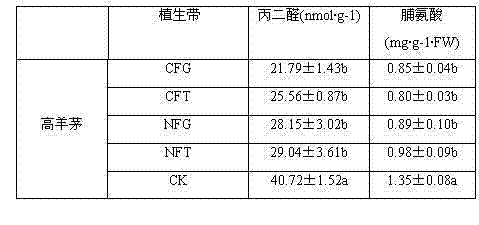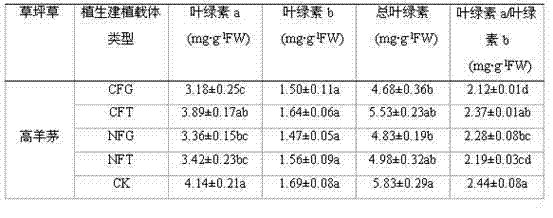Method for regulating proline and malondialdehyde of Festuca elata Keng subjected to water stress by adopting sodded strips
A technology of tall fescue and planting belt, applied in the directions of botanical equipment and methods, horticultural methods, and seed treatment methods, etc., can solve problems such as seldom use, and achieve the effect of improving effectiveness
- Summary
- Abstract
- Description
- Claims
- Application Information
AI Technical Summary
Problems solved by technology
Method used
Image
Examples
Embodiment 1
[0029] (1) Preparation of waste planting carrier materials
[0030] Select waste from the same source as the material for cultivating the planting carrier, including waste cotton cloth; waste newspaper; waste gauze; waste facial tissue; expose each material to the sun for a week, then soak in 1% hydrogen peroxide solution for 10 minutes, take out Dried in the sun; then use discarded newspapers and discarded cotton cloth as the lower layer of the planting carrier for the planting tape, waste gauze and discarded facial tissue as the upper layer of the planting carrier as the planting tape, and sow 0.5g of ryegrass seeds on a round 8 cm in diameter The area is fixed with the upper carrier to make a ryegrass planting belt to ensure the uniformity of the seeds; the method of carrier fixation refers to: edible wheat flour is put into boiling water at 100 °C and fully stirred to make a paste, then it is made Carrier fixative, and adhesive fixation; the ratio of wheat flour to water i...
Embodiment 2
[0036] 1 Materials and methods
[0037] 1.1 Experimental materials
[0038] 1.1.1 Preparation of waste planting carrier materials
[0039] Select waste from the same source as the material for cultivating and planting carriers, including waste cotton cloth, which is simplified as C below; waste newspaper, which is simplified as N below; waste gauze, which is simplified as G below; waste facial tissue, which is simplified as below T to simplify the representation. Expose each material to the sun for a week, then soak in 1% hydrogen peroxide solution for 10 minutes, take it out and dry it in the sun to disinfect and ensure the normal germination of turfgrass seeds. Respectively, discarded newspaper and waste cotton cloth were used as the lower layer of the vegetation belt establishment carrier, and waste gauze and discarded facial tissues were used as the upper layer of the vegetation belt establishment carrier.
[0040] 1.1.2 Preparation of turfgrass seeds
[0041] The sele...
PUM
 Login to View More
Login to View More Abstract
Description
Claims
Application Information
 Login to View More
Login to View More - R&D
- Intellectual Property
- Life Sciences
- Materials
- Tech Scout
- Unparalleled Data Quality
- Higher Quality Content
- 60% Fewer Hallucinations
Browse by: Latest US Patents, China's latest patents, Technical Efficacy Thesaurus, Application Domain, Technology Topic, Popular Technical Reports.
© 2025 PatSnap. All rights reserved.Legal|Privacy policy|Modern Slavery Act Transparency Statement|Sitemap|About US| Contact US: help@patsnap.com



